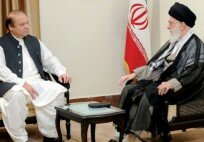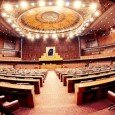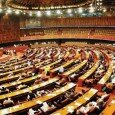Point
By Nafisa Shah –
Women leaders of Pakistan have, in no small measure, shaped the political agenda of the country, especially in strengthening political systems and democracy. Madar-e-Millat Fatima Jinnah, Shaheed Mohtarama Benazir Bhutto and Begum Nusrat Bhutto, have an iconic stature in the political history of this country, primarily because they tread on the path that no male politician would, by taking the military dictators head on. When these great women took principled positions, the entire nation, men and women equally, followed them, and their being women did not in any way obstruct these great political movements that they led.
More recently women’s appointment to key public offices such as the Speaker, Foreign Minister and Information Minister, and equally importantly, the performance of women members in the National Assembly seems to have placed women at the centre stage in the usually male world of Pakistani politics.
But are they really?
Although a significant increase in visibility and presence of women in top positions in government and legislative bodies has been a positive sign, questions abound on whether these measures are able to mainstream and create a level playing field for women in public and political space generally, as socio-cultural barriers continue to restrict women’s participation.
Quotas or reservations for women have been instrumental in increasing the numbers of women in political and legislative forums all over the world. Today 19 percent of the public representatives in the parliaments across the world are women, as a result of the instrument of quotas.
In Pakistan, Begum Jahan Ara Shah and Shaista Ikramullah were pioneer members of the Constituent Assembly, and thereafter reservations for women, no matter how small a number, have been a consistent principle in the legislative process. Women’s seats were agreed on in the first Constitution of 1956 at 3 percent , and women were elected on reserved seats through an indirect election. The revised constitutions of 1962 and 1973 also provided reservation of seats for women at 2.75 percent, and 5 percent respectively in the national and provincial assemblies. In 1985, the number of reserved seats for women in the Pakistan National Assembly was raised to 20 ( or 10 percent) for the period of 10 years or three general election whichever came earlier. When this provision lapsed, however, hardly any woman could make it to the parliament in the 90s. In 2002 elections, this was revived and improved significantly, and 60 seats were reserved for women in the National Assembly and 17 in the Senate, and these quotas have subsequently been made part of the constitution in the 18th Amendment in Article 51.
Women candidates on quota seats are elected through proportional representation system, whereby political parties produce lists of candidates on the basis of the total number, as opposed to general seats, where party candidates contest election in constituencies. However, this does not bar women from contesting on general seats and at least 19 women have returned as winners from their constituencies in the National Assembly thereby raising the percentage to 22, a little over one-fifth of the House.
Quotas are supported generally as an entry point for women in politics. “There are very strong, rigid social, cultural and economic barriers to women’s participation in politics, which the quotas have recognized and provided legitimate and appropriate ways to bring women up in politics,” says MNA and special assistant to the Prime Minister, Shehnaz Wazir Ali. Some women parliamentarians consider these as a basic democratic intervention which has given women a voice. And women have found a voice through these reservations: “ I remember when women first came on reserved seats, our male colleagues used to worry and say, ye kiya bolen gi (What would they speak on?). Today, women are speaking up, and speaking on issues that are generally not done.” For some women parliamentarians, these have provided an opportunity for women outside the structured entrenched political class to enter politics and have as a result shaken the status quo. Donya Aziz says: “I don’t belong to a political family, and there was no way I could have entered the assembly had it not been for the reserved seats.”
It is argued that increased representation of women through quotas has not only assured a presence and a visibility, it has had a direct, tangible outcome, especially in the improvement in the work of legislative bodies. Indeed the present National Assembly will, in due course of time, be recognised for its exemplary legislation on rights based agenda, particularly women rights. Aside from clear domination in running the business of the House, whether it is raising questions, moving motions, or private members bills, women have introduced important legislation: the Anti Women Practises law, the Harassment Against Women at Workplace law, Acid Crime law, are some instances.
Even though women’s space in parliamentary forums seems to be firmly placed, the very fact that women are not directly elected from constituencies, has been a point of contest. Male members of the parliament have at times stated their discomfort with these reservations and members on general seats do not want that women on reserved seats are given the same benefits, especially funds for constituency development as they do. On the other hand, women themselves consider that this is often used to discriminate against them, in allocation of cabinet portfolios, development funds, etc as Yasmeen Rehman adds. “Women have worked hard and performed, and something still seems missing as there is still a sense of discrimination against women on these seats.”
Despite the gains, the key issue is how women would take the next step of mainstreaming women in politics? If quota provisions are removed, would women again become invisible?
“When a critical mass of women do enter, then the next step is to open the next set of gates,” says Shehnaz Wazir Ali. Waiting on the next set of gates is one important gatekeeper – the political party – which, in the final analysis, holds the key to mainstreaming women in politics. This is because, to quote academic Lovenduski: “Parties are crucial gatekeepers to government office, one of the main channels of political mobilization in a society and a major source of public policy.” That is where the change needs to come, with regard to increasing numbers, presence, visibility and voice to women. These changes are crucial if quotas for women are to be met in a way that brings politically active women into public institutions. Although political parties like the PPP have brought a significant number of women in important offices, generally the parties have made little effort to encourage women’s participation in politics at all levels. One way that political parties have responded to this concern about the lack of women in both their membership and organization is to constitute women’s wings of political parties. However, women’s wings of political parties are viewed with a mixed response. Some consider them as important spaces allowing women to participate in politics, but others view them as ghettos for women. ANP, for example, vehemently opposes a separate womens wing, and has announced a 33 percent quota for women on all party councils. The PPP, however, has compromised with women both represented in what is called the mother wing, and in the women’s wing. It is now felt that there is a need to explore how political parties can be sensitized to the issues of representation of women, and to debate whether the present form of indirect representation provided to women is strengthening women’s participation in politics on a sustainable basis. It is feared that quotas may make the political parties complacent and unwilling to provide the party platform to women to contest direct elections
Political empowerment will only materialize if parties enable more women in party offices, and also to contest elections. In countries such as Britain the affirmative action of quotas has happened at the level of political parties, where some political parties have given as many 33 percent of the party tickets to women, the Labour Party of Britain being an example. The Nordic countries’ impressive women’s representation is due both to socio-economic changes, and voluntary political quotas by political parties.
Quotas for women in political parties have been discussed in Pakistan but are as yet to be introduced. This idea has now been carried forward by the Women’s Parlaimentary Caucus (WPC), which has tried to build consensus among the parties to agree on a minimum quota of 10 percent for awarding tickets to women on winnable seats and a 33 percent quota on all party committees and councils.
As a result of this consensus, the WPC has moved a bill to amend the Political Parties Act 2002 and the Representation of Peoples Act 1976. Gender mainstreaming needs to be transformative, and while quotas are essential to making women visible, institutional changes in political parties for electoral politics, are the final guarantee to ensuring women’s political empowerment. And finally, the emphasis on gender mainstreaming is not only about political and social justice, it is about good, effective and responsive politics. As British Conservative MP Theresa May once said: “We are not trying to (get more women into parliament) to be politically correct, as some people complain, but to be politically effective. Women make good MPs.”
The writer is a Parliamentarian and former District Nazim.































































































